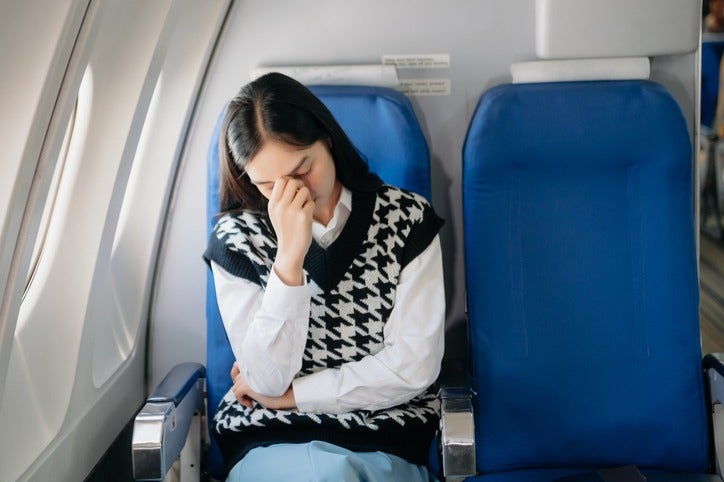Sinus Pain While Flying and How to Stop It
Flying can be an exciting experience, but for many travelers, it comes with an unwelcome side effect—sinus pain while flying. The sudden changes in cabin pressure, dry air, and pre-existing nasal congestion can cause intense discomfort, leading to headaches, facial pressure, and even ear pain. If you’ve ever experienced sinus infection pain or struggled to find sinus pain relief mid-flight, you’re not alone. Fortunately, there are effective strategies to prevent sinus pain while flying and manage discomfort if it arises.

Understanding Cabin Pressure and Your Sinuses
Flying puts unique stresses on our body’s natural pressure-regulation systems. Our sinuses—those air-filled spaces in the bones around our nose and eyes—usually handle small pressure changes without issue. But when we’re soaring at 35,000 feet, these delicate structures face challenges they weren’t exactly designed for.
The discomfort so many travelers experience stems from the relationship between our sinuses and cabin pressure. As the plane climbs or descends, the air pressure in the cabin changes rapidly. Normally, our sinuses adjust automatically through small openings that connect them to our nasal passages. However, when these passages are congested or inflamed, the sinuses can’t equalize pressure properly, leading to that familiar ache and discomfort.
Types of Sinus Pain While Flying
This pain differs from the standard sinus pain you might experience on the ground. While everyday sinus discomfort often feels like a constant pressure, sinus pain while flying typically intensifies during altitude changes.
People who are already experiencing sinus infection pain before their flight may face an even greater challenge. Inflamed and swollen sinus tissues struggle to adapt to pressure changes, leading to more intense pain. In extreme cases, blocked sinuses can cause sharp, stabbing pain in the forehead, cheeks, and behind the eyes, making air travel a miserable experience.
The Impact of the Cabin Environment
The dry cabin environment on airplanes makes sinus issues even worse. Aircraft humidity levels often drop below 20%, compared to the 40-60% we’re used to on the ground. This dry air can irritate sinus membranes, making them more susceptible to inflammation and congestion.
Additionally, the recycled cabin air exposes passengers to a variety of airborne particles, including allergens, bacteria, and viruses. Sitting in close quarters with other passengers for extended periods can increase your risk of catching a cold, which can further contribute to sinus issues.
Common Symptoms of Sinus Pain During Flight
Travelers who experience sinus pain while flying may report various symptoms, including:
- Forehead and cheek pressure: A heavy, aching sensation in the face, which can intensify during takeoff and landing.
- Throbbing headaches: These headaches often feel like they are radiating from the sinus areas, especially behind the eyes.
- Ear pain and clogged ears: When the sinuses struggle to equalize pressure, it can cause pain or a “popping” sensation in the ears.
- Nasal congestion: Stuffy or blocked nasal passages make it difficult to breathe and can worsen sinus pressure.
- Post-nasal drip: Excess mucus draining into the throat, which may cause coughing or throat irritation.
For many travelers, these symptoms can persist even after landing, making post-flight recovery uncomfortable.
Pre-Flight Prevention Strategies
Fortunately, we can tell you how to avoid sinus pain while flying. Taking the right steps before your flight can help reduce your risk of experiencing discomfort.
1. Stay Hydrated
Start hydrating well before your flight—aim for at least 8 ounces of water every hour in the lead-up to departure. Dehydration can dry out your nasal passages, making them more susceptible to irritation.
2. Use a Saline Nasal Spray
A few hours before your flight, use a saline nasal spray to keep your nasal passages moist. This can help clear congestion and improve sinus drainage, making it easier for your sinuses to adjust to pressure changes.
3. Take an Antihistamine (If Needed)
If you’re prone to allergies, taking an antihistamine about an hour before the flight can help prevent inflammation and excessive mucus production. If you regularly get allergy shots or take allergy drops, make sure you’ve taken them before your trip. Your ENT can let you know if antihistamines make sense for your condition.
4. Consider a Decongestant
A nasal decongestant spray or an oral decongestant can help shrink swollen nasal tissues, allowing better airflow through your sinuses. However, decongestant sprays should not be used for more than three consecutive days, as overuse can lead to rebound congestion. Talk to your doctor about whether taking an antihistamine or decongestant before your flight is appropriate for your symptoms.
In-Flight Relief Techniques
During the flight, several techniques can help provide sinus pain relief and prevent discomfort from worsening.
1. Perform a Sinus Massage
Gently massage the area around your sinuses using circular motions. This can help stimulate drainage and relieve pressure.
2. Use this Maneuver to Equalize Sinus Pressure
To help equalize pressure, try this technique:
- Pinch your nose closed.
- Keep your mouth shut.
- Gently blow out as if trying to inflate a balloon.
This can help “pop” your ears and improve sinus drainage.
3. Stay Hydrated and Avoid Alcohol
As mentioned, it’s important to drink plenty of water or hydrating fluids throughout your flight. Warm beverages like herbal tea can help keep your sinuses moist. Avoid alcohol and caffeine, as they can dehydrate you and worsen sinus symptoms.
4. Chew Gum or Yawn Frequently
Chewing gum, sucking on candy, or yawning can help encourage your sinuses and ears to adjust to pressure changes.
Post-Flight Care
Even after landing, your sinuses may take some time to adjust. Here are some post-flight recovery tips:
- Use a warm compress: Applying a warm cloth to your face can help reduce pressure and encourage drainage.
- Try steam inhalation: Lean over a bowl of hot water with a towel over your head for 10-15 minutes to help loosen mucus.
- Take pain relievers: Over-the-counter pain medications like ibuprofen or acetaminophen can help manage lingering sinus pain.
- Continue hydrating: Drinking plenty of fluids will help your body recover and keep your sinuses from drying out.
When to See a Doctor
Sometimes, sinus pain while flying signals a more serious issue. Seek medical attention if you experience:
- Persistent or worsening sinus pain lasting several days after your flight.
- Severe sinus infection pain with fever, facial swelling, or thick, discolored mucus.
- Hearing loss or prolonged ear pain that doesn’t improve after landing.
These symptoms could indicate a sinus infection, airplane ear (ear barotrauma), or another underlying medical condition requiring professional treatment.
Making Air Travel More Comfortable
Don’t let sinus pain ruin your travel plans—by taking the right precautions, you can enjoy a comfortable, pain-free flight. If you continue to experience sinus discomfort despite these measures, the expert team at Oasis ENT in Surprise, Arizona, is here to help. We specialize in advanced, patient-focused treatments to address sinus issues at their root, so you’re not limited to short-term symptom relief. We offer solutions that may help improve long-term sinus health depending on your condition. Whether you need personalized allergy management, minimally invasive procedures, or long-term sinus relief, our specialists are committed to finding the best solution for you. Schedule a consultation today and take the first step toward lasting sinus comfort—whether in the air or on the ground!
The information provided in this article is for informational and educational purposes only and does not constitute medical advice. It is not intended to diagnose, treat, cure, or prevent any disease or medical condition. Always seek the guidance of your physician or other qualified healthcare provider with any questions you may have regarding a medical condition or treatment.
Results may vary: Treatment outcomes and health experiences may differ based on individual medical history, condition severity, and response to care.
Emergency Notice: If you are experiencing a medical emergency, call 911 or seek immediate medical attention.


